#a group of the fantasy equivalent of 20-something adventurers
Explore tagged Tumblr posts
Text
Something notable about PC’s in tabletop is the disparity between how they’re intended and how they’re perceived and (in derivative works) written.
The intent behind most character classes, especially in DnD but present in virtually all tabletop games, is that to be “Level 1″ in something, you’re already a badass. Level 1 fighters are supposed to be veteran soldiers, bandit chiefs, and so forth. And this is borne out in the game, where you’re fully expected to be able to take on and win against multiple human or humanoid opponents, themselves trained fighters, and win easily--and then, working with a team with a similar experience level, carve through successive engagements against groups of enemies that outnumber you and/or would pulverize groups of ordinary troops and specialists, and this is treated by the game design as an ordinary adventuring day and the guy who sent you to do this fully expected you to survive and succeed.
Most of the time, however, players think of level 1 characters in mechanical and ‘this is the start of the campaign’ terms, and consider a level 1 character to be a punk newbie with barely a day of experience under their belt. They don’t consider that the above task is the sort of thing an ordinary soldier would win the equivalent of the Medal of Honor for, they just think “oh, there’s 19 more levels, this guy’s a weak-ass rookie.”
This is part of why I really, really hate “Adventurer’s Guild”s in a fantasy world. People that can regularly carve a fucking bloody path through entire tribes of Orc marauders or hunt and kill supernatural monsters terrorizing a region shouldn’t be common enough for there to be a guild based on giving them busywork errands to do.
This also ties into peoples’ complaints that in some systems high level characters don’t feel strong enough compared to low level ones. The small power gap makes a lot more sense if you stop just thinking “lol Level 1″ vs “hell yea Level 20″ and realize the starting point of a party is a gang of hardened badasses and Level 20 is just them getting even stronger. Level 1 vs. Level 20 is a battle-hardened knight vs. a warrior-demigod, not a warrior-demigod vs. a snot-nosed peasant kid.
24 notes
·
View notes
Text
Fitness games have had an interesting journey through the annals of video game history. From the Power Pad on the NES to Dance Dance Revolution’s dance mat, they have seen a lot of ups and downs. It wasn’t until the launch of the Wii and Wii Fit when fitness games became a huge deal. Why just play video games or just go to the gym when you can do both at the same time?! That proved successful as Wii Fit (and its enhanced version Wii Fit Plus) sold a combined 43.8 million units, making it one of the best-selling games of all time, even beating out games like The Elder Scrolls V: Skyrim.
Since then, everyone has tried their version of a fitness game, but nowadays fitness games are becoming less common. Once people started getting tired of that type of game, most companies and developers changed course and began work on other things. Not only that, most fitness games present themselves as exactly what they are. “Oh you’re called ‘Fitness Boxing’? So you box to the beat and do fitness? Cool.” They stay in their lane and don’t try to be anything else.
This is where Ring Fit Adventure, the latest game from Nintendo EPD, tries to break the wheel. From the initial teaser in early September to the announcement trailer, we saw people having fun with a ring and a strap, and then we found out it was an RPG. It feels like someone went, “Final Fantasy, but Wii Fit?!”
It’s not exactly a combination you’d think were synonymous with each other. However, Ring Fit Adventure manages to blend them well enough to harbor an enjoyable experience while also making you sweat.
Full Disclosure Nintendo of America graciously provided us with a review copy of Ring Fit Adventure for the Switch. This review is based on version 1.1.1. As such, the new additions will be accounted for.
Meet the newest Switch accessory
What’s interesting about Ring Fit Adventure is that it markets itself as an adventure game. You fight monsters, explore fictional lands, and collect items on your quest. It just so happens to be an adventure game that you control with your body.
Ring Fit Adventure’s centerpiece is the unique pair of controllers you use: the Ring-Con and the Leg Strap. The Ring-Con is a heavily modified Pilates ring. The main difference is that Pilates rings normally have two hard plastic handles with concave sides with padding so it can be comfortable when doing thigh workouts. The Ring-Con replaces those handles with some small padding for your hands. As someone used to a normal Pilates ring, it feels a little strange, but it’s something you get used to. Then there’s the Ring-Con attachment itself, where you put the right Joy-Con. The Joy-Con’s accelerometer and gyroscope detect the Ring-Con’s position, whether you’re pushing in on the sides or pulling them away from each other. The IR sensor also tracks your heart rate by placing your right thumb over the sensor. It seemed to be fairly accurate, as it was within a 1 or 2 bpm difference when compared to my Apple Watch.
The Leg Strap is far less high tech — it’s literally a thing that you strap to the center of your left thigh and put the left Joy-Con in. That’s it. The Joy-Con itself does the work of making sure your leg is in the right position for the exercises thanks to its gyro and accelerometer.
#gallery-0-7 { margin: auto; } #gallery-0-7 .gallery-item { float: left; margin-top: 10px; text-align: center; width: 50%; } #gallery-0-7 img { border: 2px solid #cfcfcf; } #gallery-0-7 .gallery-caption { margin-left: 0; } /* see gallery_shortcode() in wp-includes/media.php */
Admittedly, the story doesn’t try too hard to immerse you, but it still tries.
At the end of the day, however, the technology is nonetheless impressive.
One thing I do appreciate about the game is that Nintendo tries to make this game a circular experience. When you load into your file, the game asks if you want to warm up with some dynamic stretches before you jump in so you can get your body ready and avoid straining or injuring yourself. During the game itself, it’ll ask you after a while if you want to keep going or cool down. When you decide you’re done for the day, the game asks if you want to do some static stretching as a means to cool down. This structure gives a nice arc that, as someone with a movement background, I appreciate.
I’m going on an Adventure!
The story is fairly standard. You control an athlete who meets a sentient ring, and together you explore the world and fight a bodybuilding dragon named Dragaux (yes, you read that correctly). You explore many worlds, help people along the way, and gain new abilities by constantly butting heads with Dragaux.
The plot is cookie cutter, but it also doesn’t try to be anything it isn’t. The basic story line works here. It’s moderately self-aware in parts, and it’s mostly enjoyable. It’s a tad basic at times, and Ring (the only character who is fully voiced) tends to repeat lines a bit, but it’s not enough to ruin the experience.
Expecting too much from the story would be a mistake, but it will help you pretend it’s not just exercise.
The game itself is very straight forward. Levels consist of two different modes — exploration and combat. The exploration is on rails, which makes sense because you move in one of two ways, either jogging or running in place or by doing small bends (what Nintendo calls “silent mode”). Silent mode is supposed to be a way to play the game without disturbing people by running in place. It was also the mode I used more because I dislike running.
As you traverse the levels, you can pull and push the Ring-Con to release gusts of air to hit boxes and suck up coins. Additionally, you can use the Ring-Con in other positions for specific actions, like pointing it down in order to jump, twisting it from side to side to row across a river, or pushing inward with your abs to destroy rocks blocking your way. You’ll gain experience as you continue, making you more formiddable in combat.
Speaking of combat, it plays out like a traditional turn-based RPG. You attack by doing various exercises from one of four different groups: Arms (upper body), Stomach (core), Legs (lower body), and Yoga (dynamic poses). The game telegraphs how long you hold the pose and then the release of it triggers the attack. Some of the exercises make you hold position for a while (the squats are rough), while others have you move to the beat. Certain enemies are affected more by specific moves; for example, red enemies are susceptible to exercises focusing on upper body. You get to decide what exercise to use, or you can shuffle the exercises, so there is a variety. The game also aids you in combat with lots of outfits and smoothies, Ring Fit’s equivalent to potions. Outfits have a set attack and defense stat like any armor in a typical RPG. There are also smoothies to consume, which have various effects ranging from from healing damage to boosting attacks of a specific type.
You face Dragaux multiple times through your adventure, and he does have some variety in his attacks. He’ll occasionally throw boxes at you that you have to shoot with the Ring-Con, in addition to just flat out attacking you. The game also doesn’t penalize you should you die in boss battles either — it will let you just skip right to the boss fight if you want to. That choice is nice.
#gallery-0-8 { margin: auto; } #gallery-0-8 .gallery-item { float: left; margin-top: 10px; text-align: center; width: 50%; } #gallery-0-8 img { border: 2px solid #cfcfcf; } #gallery-0-8 .gallery-caption { margin-left: 0; } /* see gallery_shortcode() in wp-includes/media.php */
Ring Fit Adventure sticks fairly well to many traditional RPG elements.
That includes the nemesis that monologues and swears this meeting will be the last.
It’s not as complex as franchises like Final Fantasy or Pokémon, but it does enough to be enjoyable. And with 20 worlds to explore, there is enough content here to last you at least 20-30 hours of just adventuring alone. Additionally, during your quest, you’ll come across certain minigames. These minigames, like trying to get points by tilting your body side to side, add an extra bit of variety to the overall gameplay.
Ironically, where Ring Fit Adventure drops the ball a bit is in its overall design and music. When I think of an adventure game or an RPG, I expect a vast array of beautiful trees, vistas and dungeons. Ring Fit sets its levels in one of three locations — a trail through nature, where you explore vistas and go through caves; a wooden obstacle course built in a dojo-looking area complete with treadmills, hoops, and more; and a ruins area for the boss fights. It got to a point where I noticed how often the areas cycle between each level. After a while, it does start to feel stale.
Ring Fit Adventure’s music is pulsing, upbeat, and modern to pump you up, but most of it is also forgettable.
Music is vital to how RPGs and adventure games create the mood you should experience in combat and cutscenes. Ring Fit’s music is pulsing, upbeat, and modern to pump you up for the exercises you perform. This is great for a fitness-centric game; however, most of the music is a bit forgettable. The music often gets drowned out by the sound effects and Ring’s lines, and, when you do hear it, it doesn’t really feel like I’m a hero exploring the world and fighting monsters. I feel like I’m in a fitness studio. For a game that’s marketed to be an adventure game first, it feels like they came too short.
Additional fun to be had
Of course, the adventure is only one part of Ring Fit Adventure. The game also provides some additional modes if you don’t have time to spend on the main campaign. The Quick Play mode has a fairly robust set of minigames and exercises you can do, separated into three categories: simple challenges (where the goal is to get the highest reps possible); minigames (more specific exercise with concrete goals, like making pottery while squatting to raise and lower the hands); and sets (consisting of pre-selected exercises from upper arms to glutes or from aerobics to flexibility). You can adjust the strength setting to make things easier or more challenging depending on your ability, and these modes are a very good way to quickly target a small set of muscles.
Your scores for these are also put online to see how well you stack up against other players. At this point, the rankings are all that online is really utilized for. It’s sort of disappointing that Nintendo didn’t add a way to play the adventure mode with online co-op, but maybe that’s just me.
There’s also Custom Mode, where you can make your own workouts using all sorts of different exercises. They have some preset options, or you can pick and choose from the standard Upper Body, Core, Lower body, and Yoga menus.
At least the devs acknowledge you’ll be binging Netflix at some point. “Multitasking,” indeed.
Lastly, there’s Multitask Mode, where you can work out using only the Ring-Con while you’re not playing the game. Basically it records the number of presses and pulls you do with the Ring-Con while the Switch is in sleep mode or turned off. Once it’s enabled with the right stick, you can continue doing other activities, like watching The Mandalorian on Disney+ (at least that’s what I’m doing) and exercise while you do it. The next time you boot up the game, you’ll get a bonus in the Adventure Mode according to how many presses you did. It does limit you to 500 reps, which seems low to me, but considering that most people are going to just sit and watch a movie or a TV show for more than two hours while exercising, I understand.
A nice way to gamify exercise
Despite the story falling a bit short, Ring Fit Adventure is still a very enjoyable experience with a lot of replay value. It has several different modes to play, a terrific variety of exercises, and is great if you want to get some workouts in when you don’t feel like leaving the house because of bad weather. If you’re a fan of the hardcore mechanics of RPGs like The Elder Scrolls, Final Fantasy or Pokémon, Ring Fit may be basic, but that’s not what it places its emphasis on. The mechanics are accessible so that anyone can pick it up and enjoy it, and maybe It’ll get people into traditional RPGs. The only thing holding it back is not doubling down on the adventure/RPG genre in terms of scenarios and music.
Score 7.5/10
Review: Ring Fit Adventure may be basic, but it nevertheless makes exercise fun Fitness games have had an interesting journey through the annals of video game history. From the Power Pad on the NES to…
11 notes
·
View notes
Text
Favorite Books of 2018
I read a lot of books in 2018. Here are my favorites (not counting books I re-read), in basically no order. (But actually kind of an order.)
22. Going Rogue, Drew Hayes
Going Rogue is the third book in Drew Hayes’s Spells, Swords, and Stealth series. The series is told in two parts: it follows a group of people playing a Dungeons & Dragons-style role-playing game and a group of non-playable characters in the world of said game. The thrust of the story is on the group of NPCs, which unfolds as a typical fantasy adventure. It’s got a straightforward quest narrative, an adventuring party (turned found family), and impossible odds. As the stories progress, the players begin to sense that the game has its own agency and the characters begin to sense that there may be someone controlling their world. But mostly it’s a fun, self-aware take on a typical fantasy adventure that toys with fantasy tropes.
21. Americanah, Chimamanda Ngozi Adichie
I steeled myself for dense literary fiction when I cracked open Americanah, the story of Ifemelu, a Nigerian girl who moves to America and wrestles with race and identity. But that was all for naught because Americanah was one of the easiest reads of the year. The writing is breezy, and the story is funny and brisk. It dissects race and culture in America both by showing (Ifemelu’s struggles to define herself in a new country) and telling (Ifemelu’s hilarious blog posts). Chimamanda Ngozi Adichie seems to have perfected the art of delivering dense observations in delightful, consumer-friendly prose. Old white dude authors should probably take note.
20. What If It’s Us, Becky Albertalli & Adam Silvera
If I’m going to read a romance, I want it to be light, fluffy, gay, and conflict-free. And that’s exactly what What If It’s Us delivers. The book begins with a meet cute: while mailing a box of his ex-boyfriend’s stuff, Ben bumps into Arthur at the post office. Arthur and Ben are both appropriately awkward and endearing, bumbling and pawing their way through a relationship as only teenagers can. Every character is essentially kind and caring. There are no villains or bullies, no one gets ostracized or beaten, no one dies. The tension mostly stems from the fact that Arthur is only in the city for the summer, which only barely counts as a conflict. And while the universe of the story may be unrealistically polished, their relationship is refreshingly imperfect. Adam Silvera and Becky Albertalli are telling a story of young love, not necessarily true love.
19. The Collapsing Empire / The Consuming Fire, John Scalzi
John Scalzi built an astoundingly engrossing world in The Collapsing Empire. The human race has colonized far flung planets with the help of the Flow system, naturally occurring pathways between various planets across the universe that allows otherwise impossible interstellar travel. The Collapsing Empire follows the sharp, sarcastic Cardenia Wu, the newly crowned empress, and sweet, in-over-his-head Marce Claremont, a Flow physicist in far-flung End who has discovered something off with the Flow. It’s got a roiling pace, packed with space battles, political jockeying, and a whole host of delightful characters. It’s one of those audiobooks (narrated by Wil Wheaton) that was so compulsively listenable that I ended up taking long, meandering walks just to hear what happened next.
18. The Shell Collector, Anthony Doerr
Anthony Doerr’s writing is incredible. His sentences all feel divined from the ether. And the short story is the perfect vehicle for that writing, lasting just long enough to build an atmospheric world. Most of the stories are tinged with a little magical realism, used mostly to underscore the unique, grounded humanity of his characters. The collection dives into the histories of people who are in various degrees removed from society and intertwined with nature. But the ultimate thesis, refreshingly, is not about the corruption of society, but rather the inherent value of people.
17. Giovanni’s Room, James Baldwin
I don’t know that I have anything new or interesting to say about James Baldwin’s Giovanni’s Room. A story about desire, and maybe love, between David and Giovanni, every word of that book is filled with intense, crushing emotion desperately crashing onto the pages. It’s about love and sexuality, told in an intimate-verging-on-claustrophobic manner. It’s powerful and interminably depressing and beautiful and devastating. But it’s not devastating because it’s gay, it’s just both devastating and gay.
16. Goodbye, Vitamin, Rachel Khong
Goodbye, Vitamin opens with the main character, Ruth, going through a breakup and dealing with early signs of her father’s Alzheimer’s disease. And somehow, Goodbye, Vitamin is also fun, funny, and heart-warming. The book is sunny and endearing, even as Ruth herself struggles with caring for her father and finding her own identity. Most things described as quirky may be better described as annoying, but there truly is no better word for this book’s sensibility than quirky. The specificity of the descriptions and the cleverness of the wordplay make for a delightful, sometimes deeply poignant, read.
15. Less, Andrew Sean Greer
In many ways, Less shares beats with the incredibly overdone, deeply uninteresting novel about a middle-aged white guy who goes through a midlife crisis and suffers the pain of his own brilliance. Indeed, Less follows Arthur Less as he hits fifty, gets invited to his ex’s wedding, and then travels around the world to avoid confronting any of his problems. But Less is decidedly different: it’s gay. Which means it’s funnier, sharper, and drastically more self-aware. Arthur Less - and Andrew Sean Greer - recognizes the absurdity of his disproportionate reaction to relatively minor problems. He has no delusions of grandeur. He’s not on a journey to unlock his inner genius, just a journey to maybe buy a new jacket and have a fling or two. It’s delightful and funny and warm even as it pretends not to be.
14. More Happy Than Not, Adam Silvera
The devastation of More Happy Than Not cuts in sharp pains and deep gashes. The tragic turns - and in a book about a teenage kid who considers a science fiction equivalent of gay conversion therapy there are many - come as punches to the face, not as lingering aches. And yet, the book doesn’t feel punishing to read. Adam Silvera derives no pleasure from Aaron’s, the aforementioned teen, suffering and carefully builds the foundation of Aaron’s character on his triumphs and joys. Aaron’s life is vibrant and bristling with possibility, streaked, but not consumed, by pain. More Happy Than Not is meticulously plotted and paced, with a few moments of genuine surprise. As always, Adam Silvera writes about tragedy in an entirely uncynical way, with a deep well of generosity for his characters.
13. Witchmark, C.L. Polk
In many ways, Witchmark feels like the book I spent this entire year trying to find. Witchmark takes place in a pseudo-historical early 20th century England-style setting, in the throes of some capital-W War. Most of the book is styled as a mystery: Miles, a former army doctor, and Tristan, a mysterious outsider, track down clues and chase leads to find a murderer. And, of course, maybe they fall in love along the way. And, oh yeah, Miles is a witch. Oh and also, maybe there’s some royal family drama happening as well. And maybe also some government conspiracies. And also maybe a much larger mystery that involves all of the above. There’s magic and romance and mystery and intrigue and action, and every part of it is completely satisfying. Especially if you’re the type of person who would like to read a scene in which said army doctor needs help undressing because he broke his wrist, and luckily there’s (literally magically) handsome mystery man there to help him!!! (Listen, I never said this was particularly profound literature.) But like, five stars.
12. Mr. Penumbra’s 24-Hour Bookstore / Sourdough, Robin Sloan
If you want a cozy, feel-good novel that has just the slightest dash of magic, then pick up a Robin Sloan book. Both Mr. Penumbra’s 24-Hour Bookstore and Sourdough read as relaxing balms to help soothe aches brought on by the disaster fire of reality. In both books, a young twenty-something attempting to figure out their life discovers a niche world (book collecting and bread baking) and gets swept up in a fantastical mystery. They’re breezy, warm, and brimming with genuine affection and curiosity for the subjects at their centers. Sloan’s writing is incredibly sensory; you can taste the bread and smell the books. They have that Great British Bake Off quality to them: impossibly compelling despite low stakes and uniform pleasantness.
11. Little Fires Everywhere, Celeste Ng
Celeste Ng’s second novel is a careful study of privilege of all sorts, and an especially incisive look into whiteness. Little Fires Everywhere takes place in Shaker Heights, Ohio, a progressive slice of white suburbia. At the book’s center are the Richardsons, a well-off white family who are the types of people that may tell you that they don’t see race--in part because everyone they see is also white. Things get shaken up when Mia Warren and her daughter Pearl arrive in town, marked as strange by their relative lack of wealth, and marked as even stranger by their lack of shame about it. Each sentence is beautifully written, and each paragraph immaculately constructed. But honestly, the book is best summed up as: this is some white people nonsense.
10. The Lymond Chronicles (#1-6), Dorothy Dunnett
The Lymond Chronicles books are both the most high brow and most low brow books I read this year. They are densely written and plotted, with an inexhaustible supply of names for characters and teeming with minute details that almost all portend some future event or revelation. But they’re also chock-full of soap opera-style twists and tropes, aimed to quench your id’s every desire. All this makes for books that demand a lot, but then pay off with hilarious jokes, action sequences that convey more physicality and movement than most movies, and ridiculous third act reveals that are so incredibly satisfying. And like, on a selfish level, it’s also real satisfying to read about people falling in love with and then aggressively berating Francis Crawford for three thousand pages. (He deserves it.)
9. My Life as a Goddess, Guy Branum
I read, or rather listen to, tons of memoirs - by comedians, actors, politicians, and writers. And Guy Branum’s My Life as a Goddess is easily my favorite of the year. Branum incisively writes about growing up as a gay kid in truly the-middle-of-nowhere California, touching on issues of masculinity, sexuality, class, body image, and education. Unsurprisingly, My Life as a Goddess is hilarious, chock-full of jokes and witty observations. More surprisingly, My Life as a Goddess is also deeply emotional, especially as Branum writes about his relationship as his father. Even more surprisingly, My Life as a Goddess is weirdly informative about a very specific slice of Canadian history. I cannot recommend the audiobook of this enough, as Guy Branum’s narration is smart, funny, and winning.
8. All the Light We Cannot See, Anthony Doerr
Does anyone really want to read a Pulitzer Prize winning literary fiction novel written by some white dude about World War II half from the point of view of a goddamn Nazi? No. No one wants to read that. Except, maybe I do. Because that’s exactly what All the Light We Cannot See is, and man is it a true revelation. The sheer humanity that Doerr imparts in his story creates a profoundly moving story, about goodness and cruelty and the indiscriminate destruction of war. The events of the story are uniformly bleak, as expected in a World War II novel, and yet the book’s tone feels decidedly hopeful, hungry to extract optimism from human persistence. It’s a stunningly written book that lays bare the complexities of people and the horrors of war.
7. Bad Blood, John Carreyrou
Bad Blood was truly the most unbelievable story I read this year. Wizards? Aliens? Time travel? All relatively believable compared to the intense, densely plotted, thrilling tale that unravels in Bad Blood, made all the more incredible by its truth. Bad Blood tells the story of Theranos, a Silicon Valley startup that claimed to be revolutionizing blood testing, and its founder Elizabeth Holmes, once described on magazine covers as “the next Steve Jobs.” John Carreyrou, the author, was the journalist who first broke the story of Theranos’s rampant fraud, and he stitches together a coherent, mesmerizing narrative from first-hand accounts of Theranos employees. Elizabeth Holmes is a fascinating antagonist, an ambitious, callous, maybe sociopath. The story is exciting and frustrating and will make you have even less faith in rich, powerful white people. But because this is non-fiction, the entire time you know that Elizabeth Holmes is eventually going to end up being charged with numerous federal crimes. A truly satisfying ending.
6. Hyperbole and a Half, Allie Brosh
Allie Brosh didn’t invent the internet, but she at least has as much claim to modern internet culture as any other individual. Hyperbole and a Half is a collection of her best blog posts, with some additional, equally hilarious, stories thrown in. I hadn’t revisited her blog in years, and so it was striking just how little her style has aged. In a time where internet memes have life spans measured in hours, Hyperbole and a Half feels fresh nearly a decade later. The influence of her style and perspective on the internet is far-reaching. From the hilarious (her distinctively drawn self-rendering triumphantly declaring “CLEAN ALL THE THINGS” while holding a broom) to the insightful (her two-part essay on the amorphous gray muck of depression), her stories all feel as though they could be the origin story for any piece of internet ephemera. Hyperbole and a Half is at times farcical, at times poignant, and always raucously funny.
5. Shades of Magic (#1-3), V.E. Schwab
The Shades of Magic series (A Darker Shade of Magic, A Gathering of Shadows, and A Conjuring of Light) is the perfect fantasy adventure: the characters are imminently rootable, the world is seeped in magic, and the plot is intoxicating. The books are set in London, or Londons, rather. There are four parallel Londons, which have embraced, rejected, or surrendered to magic to varying degrees. Our protagonist, Kell, is one of the few with the ability to travel between the different Londons. And, well, hijinks ensue. Dark, sprawling, brutal, violent, life-consuming hijinks.
The Shades of Magic series is unburdened by its worldbuilding; V.E. Schwab could probably teach a semester’s worth of history lessons on her world, but does not feel the need show that off in the books themselves. They’re books to be devoured, not dissected. But it’s the characters that make the series so engrossing. Everyone is an archetype-a street-worn thief, a charming prince-but so well-drawn and understood that every character moment sparkles. And the central relationship of the book, between Kell and his brother Rhy, felt as though it was perhaps extracted directly from my brain. Kell is stoic, burdened by responsibility but determined to protect. Rhy, the aforementioned charming prince, injects Kell’s life with mischief and levity, and they’re so fundamentally dedicated to each other that it hurts. If a bunch of well-meaning idiots trying to save the world with magic is your thing, A Darker Shade of Magic may be the series for you.
4. Everything I Never Told You, Celeste Ng
If you thought a quiet, contained rumination on race, gender, nationality, and culture couldn’t also be a compelling, tense page-turner, let me introduce you to Everything I Never Told You. Everything I Never Told You is nothing short of literary alchemy. It begins with the death of Lydia, the model daughter of the Lee family--and, really, the model daughter of 1970s America. The book unravels the mystery of Lydia’s death, told through the vignettes from the lives of the Lee family members.
Celeste Ng is a master at using a paragraph to describe years of a character’s history and decades of American society all at once. Her characters are specific and sharply drawn, rooted deeply in their time and environment. Lydia, with a Chinese father and a white mother, is mixed race (a term not added to the U.S. Census until 2000)--“one of only two Orientals” at her school. The other, her brother Nathan, has learned to live in Lydia’s shadow in their parents’ mind’s eye. Marilyn, Lydia’s mother, had her own ambitions sidelined by family. With a deft, heartfelt touch, Everything I Never Told You viscerally conveys their regrets for the words left unsaid and lives left unlived.
3. History Is All You Left Me, Adam Silvera
As this list makes clear, I loved a lot of Adam Silvera this year, and History Is All You Left Me stands out as my favorite. In dual timelines, History Is All You Left Me tells the story of Griffin after and up to the accident in which his ex-boyfriend Theo dies unexpectedly. And so, yes, the book is soaked in grief and loss. And, yes, it’s devastating and aching. But it’s also incredibly kind and empathetic. The characters are teenagers and make the choices of teenagers. Their actions are messy and rash and stupid, and Silvera leans into that, landing more than one self-inflicted heart-wrenching blow. But Silvera is also unfailingly patient with teenagers and understands their resilience; he lets his characters make mistakes and has faith that they will survive. And so the book is heavy, but optimistic. A refreshing reprieve from the gratuitous suffering and bleakness that tortures so much LGBT-themed fiction. History Is All You Left Me is the most affecting book I read all year, and it still lingers in my bones. But the impression it has left is of life, not loss.
2. An American Sickness, Elisabeth Rosenthal
I bristle when someone describes a book as “important.” It always seems patronizing and self-serving, and my natural contrarian kicks in. I get it, you want to tell everyone how well-read or socially conscious you are because you read an “important” book. So it is with eyes wide open, and more than a twinge of self-loathing, that I say An American Sickness is an important book. It feels like essential reading, certainly for anyone trying to affect American healthcare policy, and at the very least useful for anyone who ever has to deal with the American healthcare system. It will make you angry and frustrated, but hopefully it will also arm you with information.
An American Sickness is broken up into two distinct parts: the first half lays out the issues with the current healthcare system, including how it came to be, and the second half presents solutions. Dr. Elisabeth Rosenthal writes accessibly about potentially dry, dense subject matter. The book’s purpose is not to exhaustively detail the history of healthcare, but to better equip the average person to navigate the system. Dr. Rosenthal provides anecdotes to anchor the matter in tangible issues and gives just enough context to sketch the motivations of the various actors - doctors, hospitals, insurers, pharma companies, etc. She presents solutions from two perspectives: (1) changing healthcare policy as a whole, and (2) navigating the system as an individual. In a methodical, step-by-step manner, the book explains concrete things a regular person can look out for, questions they can ask, and actions they can take to avoid--or challenge--exorbitant medical bills. There’s literally an appendix with fill-in-the-blank form letters to use to request billing information and challenge bills. You don’t have to read this book, but I want you to.
1. Chemistry, Weike Wang
Sometimes a book is so intimately catered to you it’s as if the author waded through your subconscious, fished out the tangled threads of your thoughts, and then wove them into a tapestry that displayed every single one of your hopes, dreams, and aspirations. For me, that book is Chemistry. Chemistry follows an unnamed Asian American protagonist who is discontented with her current situation: her long-term boyfriend, her Chemistry PhD program, and her relationship with her parents. And the novel unfolds as she comes to terms with that discontentment.
The economy of Weike Wang’s writing is spellbinding. She uses words so efficiently and so cleverly to craft sentences that seem fundamental. On seemingly every page, there was a new observation that felt so obviously true that I was surprised I had never read those exact words before. The book is filled with jokes, driven by the protagonist’s wry sarcasm and gentle disdain for things and people generally. The whole thing is somehow both simple and complex, an easily digestible read with a deceptively complex flavor. There are no splashy revelations or sudden tragedies, only hard-earned emotional truths and the realities of getting by. Chemistry nails the general spirit of just attempting to function as a normal human person in 2018.
8 notes
·
View notes
Text
Nighthawks’s Kickstarter and interview with author
Hey guys, you might have seen this kickstarter over the past month, as its approaching its deadline I thought I’d interview the main dude for you guys :)
I played the demo that’s available, which isn’t fully representative of the story’s debth (as it was meant to be just a small visual fiction), which displays great attention to art, great voice acting, and quite nicely written characters and unique starting situation.
Overall I really love the concept and I’d like to see this game become a reality, we need down-to-earth games even if they’re not labelled WoD :p
Here’s the link to the kickstarter. You can get the game for just 20 bucks ^^ HURRY though, it ends in FIVE DAYS.
The author, Richard Cobbett, has done lots of work in the past, and the publisher is a solid one too (the publisher’s TechnoBabylon is just life, and Sunless Sea/Skies were made by this author), it’s not his first rodeo and he’s, as he put it in the discord server: “I'm writer, designer, programmer, marketing person, video compositer, UI engineer, community manager and basically everything not involving drawing“. His wording isn’t pretentiously all over the place and “darker than thou”, but it has the right amount of work from hat I could see from the screenshots and the demo.
So here goes! Interview under the cut!
“Who are you, apart from what we know from the Kickstarter?”
I’m Richard Cobbett, and if you know me from anything it’s probably about 20 years of games journalism, including things like PC Gamer’s “Crap Shoot” column and Rock Paper Shotgun’s “The RPG Scrollbars”, or my work on Sunless Sea/Sunless Skies. But I’ve done quite a lot more than that, including the mobile adventure Silent Streets and the space game The Long Journey Home.
So, this is far from my first rodeo. I love cats, hate spiders, and once made a pitch to White Wolf that included the secret goal of making my home town of York a Tremere stronghold. I am entirely serious about this.
“In a few words, for a VtM Audience, what is the premise of Nighthawks' world?”
Vampires exist. You know this, because you’re one of them. But unlike the World of Darkness, the Masquerade has failed. You’ve been exposed, and the world is trying to figure out where to go next. You begin as a penniless vampire in a shitty hotel in the cheapest part of a dying town, and Nighthawks charts your rise from rags to riches as you become part of the new politics.
Things are of course very different from WoD, both to avoid treading on White Wolf’s paws and because of course I wanted the fun of creating my own setting! For starters, Nighthawks is a bit lighter in tone, and more rooted in the problematic elements of being a vampire. Blood tastes foul, being bitten hurts, and the world is at best incredibly suspicious and at worst outright hates you.
Also, vampires don’t secretly run the world. They’re more like cats, in that they’re fiercely individualistic and territorial, with many of them not even having historically known that there were others like them. There’s a few groups here and there that have had some historical sway in the world, such as the Eternal Dynasties that latched onto the great courts of Europe like parasites, and a handful of aristocrats who spread with British colonialism to find Heirs to further refine their bloodlines, but they’re very much in the minority.
The closest equivalent to the Masquerade is that some - not most, though you’re one of the lucky ones - have powers. These are primarily mental rather than breathing fire and turning into bats and so on, like Mesmerise or Corpse-Talking or copying the face of a human for a brief period. Vampire society is doing its best to hide the existence of these for fairly obvious reasons - they’re already distrusted enough! They’re also not skills to just spam at problems, but very expensive aces-in-the-hole to deploy very carefully.
There’s a lot more to say and discover about the world, but in short, it’s something that I think Vampire fans will both enjoy for the parts of the atmosphere it shares, and love exploring for all the cool ways that it tries something a bit different. It’s a game rooted in the social side of vampire life, where a dinner party can be more dangerous than any back-alley rumble, and one where you get to be a direct part of the big decisions that define what it means to be a vampire, versus showing up five hundred years after the Convention of Thorns or whatever already laid out how things work.
It’s also a game designed to let you play whatever character you want - both in terms of things like sexuality and gender, and just background. You’re not restricted to just being JC Denton with fangs. If you want a character who was, say, a hairdresser in their mortal life and who has never been in a fight, that’s just fine. Or, of course, you can be a bruiser. Everyone deserves the chance to be a badass vampire, and a badass vampire that fully represents them.
Hmm. That was quite a few words, wasn’t it? Sorry. I get excited!
“What are its mechanims and gameplay like? How long do you think it will take for an average player to beat the full game?”
We’re looking at around 15-20 hours for a playthrough, with a ton of replayability. Lots of choices, differences in character builds, cool things to discover… the lot. We’re primarily using text because it allows us to really flesh out the world and add as many stories as possible.
Mechanically, it’s a mix of life-simulation and RPG. It resembles games like Sunless Sea, in that most options are chosen from a list, alongside some gorgeous 4K graphics and voice acting. However, under that is a fierce system of RPG options and life simulation. Every click is a tick of the clock, as you explore the city, improve your character, and get back to safety before sunrise. Rather than the standard critical path of quests, the design is based around Objectives. In the first act, the simplest, your main goal is pretty much just making sure you can pay your hotel room bill. How you go about that is up to you, whether it’s hunting, taking on assignments, investigating rumours and so on. Later chapters of course get more complicated as you have to balance basic survival with dealing with crooked cops and politics.
I’ve posted a lot about the game design and where we’re going with it all in the Kickstarter Updates. Worth checking out! I think V:TM fans will really like it.
“What got you into vampire fiction and vampire games? Why make a game with those themes?”
Firstly, urban fantasy is awesome and it’s depressing that we see so little of it in gaming. Vampires specifically intrigue me as a designer because they offer so many mechanical opportunities - blood, sunlight, etc - and as a writer for the constant dichotomy between power fantasy and personal nightmare.
Nighthawks is very much rooted in exploring that, with some characters who find their undeath a curse, others who find it liberating, and with the player allowed to decide for themselves where they stand. It doesn’t hurt that the individualism of vampires allows you to create some really awesome characters who are fun to hang out with. Our Kickstarter backers immediately connected with the Companion in the demo - Madame Lux, a vampire stage magician with the power to manipulate human sight. She’s just one of many really vibrant characters, including con-artist cult-leader Maze, vampire fangirl bartender Becca, and Inez, a pirate queen from the Golden Age of Piracy struggling to adapt to a world where none of her skills are still in any demand.
Then throw in all the awesome vampire folklore from around the world, and you’ve got a fantastic palette to paint with. Much of the Nighthawks design makes me grin just to think of it, and I think players are going to dig it too.
“Favorite VtMB story part? NPC?”
Well, as a paid-up fan of the Tremere, obviously, Strauss. Good egg. Totally not like that awful LaCroix chap. Other than that, Heather and Tourette are obviously the first ones that everyone thinks of, and with good reason. Grey de Lisle’s voice makes any character awesome, and the Heather sequences were shockingly brutal the first time around. Absolutely amazing writing in those bits.
But I’m probably going to say Deb of Night. I love radio in games as a way of conveying atmosphere, and that’s one of the best one. I don’t know if it’s cool or sad that a few years ago I was in Santa Monica on a press trip, and spent some time wandering around the Pier while listening to Deb’s show. Bit of both?
“Anything you'd need apart from more backers to make sure the game becomes a reality?”
Moral support, really! Game development is a long and often pretty lonely experience, where you never usually know if anyone is going to want what you’re making when you’re done. It’s a real boost to know that so many people are excited by Nighthawks and really want to see it happen. That certainly adds some pressure, but the kind of pressure I think everyone can appreciate!
15 notes
·
View notes
Text
Raiders of the Lost Ark; AFI #66
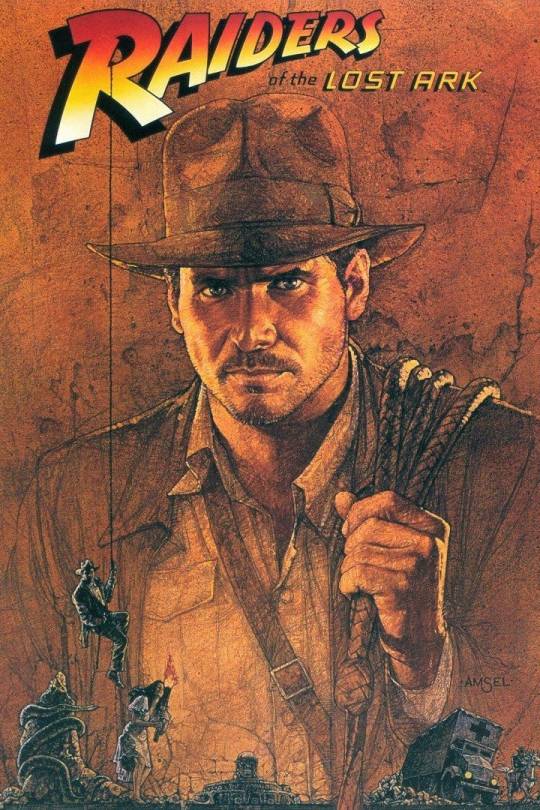
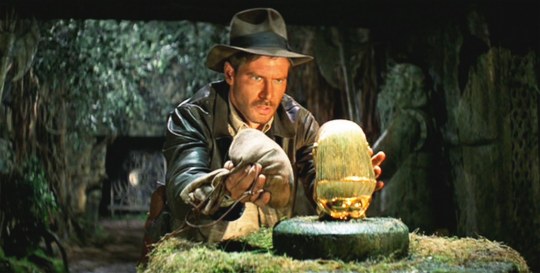
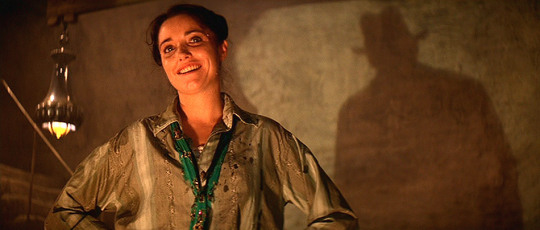
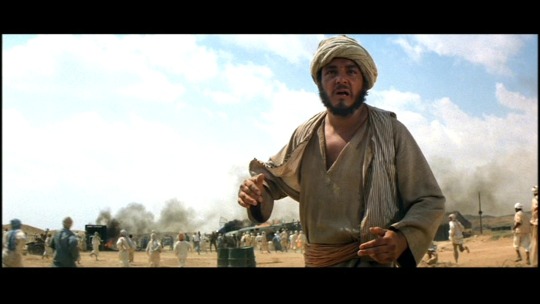
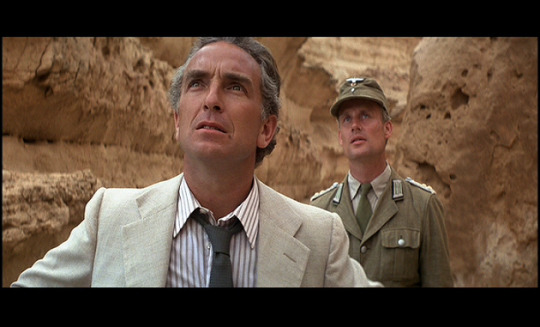
The tenth film the group reviewed from the AFI list is the magnificent adventure, Raiders of the Lost Ark (1981). This movie might be one of the most fun to watch films ever, and critics have agreed with that sentiment for close to 40 years. The film was nominated for 9 Academy Awards and won 5 of them. Sadly, but deservedly, the movie took all the technical awards, but none of the acting/directing/writing awards. This makes since as Raiders came out the same year as Reds, On Golden Pond, and Chariots of Fire. That is some stiff competition and, since the Academy seems to favor drama over action, Raiders did not have much of a chance. Interesting, though, that Raiders of the Lost Ark is the only Best Picture nominee from that year to be included on the AFI 100. The film also won #10 on AFI’s Greatest Thrills and #2 Greatest Hero. It also swept the Saturn awards as it was an immediate hit with the sci-fi and fantasy adventure crowd.
The movie is about the story of Indiana Jones (Harrison Ford). The film begins with Jones in a jungle and finding some ancient ruins with many traps protecting something he is after. His guides are soon shown to be working against him and Jones barely escapes the ruins alive with a golden idol (but not without being chased by a massive rolling boulder). He immediately runs into a rival treasure hunter named Belloq (Paul Freeman) who tries to kill Indy, but Jones escapes in a dramatic sea plane scene. So far, so good.
Jones is shown after his heroic escape to actually to be a professor of archeology at Marshall College, not just a treasure hunter. He is the hunky teacher that all the students crush on, but Professor Jones does not seem to care about these things. He is, however, interested in an offer to go to Cairo to find the Ark of the Covenant before Nazis do. He also wants to send the Ark back to the museum for study instead of using it as a weapon, the thing which Hitler apparently wants it for.
He starts out by going to Nepal because an old colleague has a medallion that goes on top of a staff that reveals the location of the Ark. Upon arriving at an old bar in Nepal, he finds that his old colleague Abner Ravenwood is dead, but the daughter Marion Ravenwood (Karen Allen) is there with the headpiece. She and Indy have romantic history of which she seems angry about, but the reunion is immediately interrupted by a very strange Nazi interrogator (Ronald Lacey) who tries to take the headpiece. Indy and Marion are able to fight off the Nazi and his goons and escape, but the Nazi manages to get some information from the headpiece to start looking for the Ark.
Indy and Marion go to Cairo and meet his Egyptian contact Sallah (John Rhys-Davies) and gather information about the Nazi dig for the Ark. I really don’t want to spoil the process of looking for the Ark because it is so much fun. There is a lot of fighting off Nazis and Egyptian mercenaries, a lot of tomb raiding, and Jones’ rival Belloq shows up as the leader of the Nazi dig. There is a point where Indy does find the Well of Souls (where the Ark is kept) and it is full of snakes. He is found out by Belloq and the Nazi group and they steal the Ark from Jones. Indy follows the Nazi convoy and is able to steal back the Ark and hires a pirate boat to get him, Marion, and the Ark back to the U.S. Sadly, the boat is found by a Nazi submarine with Belloq aboard and the Ark is confiscated by the Nazis along with Marion. Indiana is able to stow away on the submarine as it goes to a small island to test out the power of the Ark.
Again, I don’t want to spoil too much, but I will say that Indiana Jones is captured and both he and Marion are captives when the Nazis attempt to open the Ark on the island. Let us say that it doesn’t go well. The power of the Ark is not kind to Belloq and the Nazis and it is far and away the most disturbing violence in the movie (I used to cover my eyes when I was a kid). Indiana and Marion survive and bring the Ark back to the states. Unfortunately, the government confiscates the prize and puts it in a giant storage unit where it will assumedly never be found. Cue the music and the end of the movie.
I think that the fun comes from the pace of the movie because I think it is 70% action/drama, 20% puzzle solving, and only about 10% establishing. It is a very stereotypical “guys” movie and the inner 13-year-old boy in me absolutely loves every second of it. Both George Lucas, who wrote the film, and Steven Spielberg, who directed it, wanted to remake the adventure film serials from the 30s and 40s. This was the equivalent of weekly adventures that would have been on TV if the technology existed, but instead were put out in cinemas and were favorites of younger boys. Neither Lucas nor Spielberg are old enough to have been alive for these serials when they came out, but they bonded over their affinity for the style.
This movie is especially known for the sounds, sets, and cinematography. Some tomb scenes in the movie were filmed on sets in California, but the Cairo scenes were shot in Tunisia, the jungle scenes in Hawaii, and the submarine and docks were shot in France. It is not what one would call “on location” filming, but all the areas are gorgeous and well utilized. I love the John Williams score for the film, as he always does a great job, but I love the sound and sound editing on this film even more. Traditional foley artists used especially loud guns fired in echo chambers to “beef up” the gunshots. The fight sound effects are simply baseball bats hitting leather gloves so the punches sound weighty and devastating. This is very unrealistic but much more satisfying for the audience.
This movie is so much fun, I was able to watch it three times in five days without hesitation. I saw it initially on my laptop with headphones and was blown away by the sound effects (like I am every time). This is definitely a film to enjoy with the guys, so I also watched with my housemates on the big TV and it was a lot of fun. There was no playing with phones during this movie because it just does not stop with the action. FInally, I watched on my room TV to take plot notes, but had the sound down because it was rather late at night. Still a fantastic experience. I think what I am trying to say is that it doesn’t matter what size screen or sound system you have when you watch this movie. It also doesn’t matter if you are alone or in a group when watching the movie. It will be fantastic in about any situation.
As far as a recommendation, it is a resounding yes. Please do. Treat yourself to 90 minutes of awesome fun. I will say that the first and last 10 minutes might be a bit frightening for the very young and the especially sensitive, but it is otherwise pretty tame as far as scares go. The film is not in the same league as something like Citizen Kane or The Godfather, but it is still fantastic and has had as much influence on Americana as either of those movies. In my opinion, Raiders deserves the spot it has on the AFI list and is the perfect example of a fun American action film.
#raiders of the lost ark#Indiana jones#action#adventure#academy awards#afi films#punches#spoilers#movies#films#sound effects#cinematography#harrison ford#john rhys-davies#karen allen#steven spielberg#george lucas#film critique#movie review#introvert#belloq#marion ravenwood#nepal#ark of the covenant#egypt#cairo#tomb raiding#treasure hunting
7 notes
·
View notes
Text
Review & Playtest: Creep, Skrag, Creep! (DCC)
I have a comparatively long history with the Dungeon Crawl Classics (DCC) RPG, and when I wanted to ease my GM-ing burden recently, I convinced my group to dedicate half our sessions to playing premade modules for this game. The reasons were simple - hardly any publisher I know makes so many good, fun modules consistently as Goodman Games does, the system is also simple, and one of my players owned the core book without ever having played it.
I personally tend to believe that fantasy is best seen from a horror angle. I mean, look at the content of a typical monster manual! And the flavor text is probably the only thing worse than the pictures, usually adding gruesome details awaiting those tricked or bested by those critters. So I was happy when M. found me a funnel made by Goodman Games that I not only already owned, but that was designated as part of their new horror line.
I emphasize found, because navigating the online store I had relied on tags and not come over this one. Better clean that one up, Dark Lord... But the search did do its job. Another oddity is that Creep is apparently #5 in the new DCC Horror line, but the only other adventure I saw was Sinister of the Sempstress which supposedly #2. It seems the Halloween line has been rebranded, but I guess this rebranding will be only complete when the other modules in it will be reprinted.
If this gives them a reason to release more of them than just once per year I’m all for it. Sadly, Creep is an ambitious module with many flaws, not living up to its potential...
Lists for lists’ sake
What does this adventure have aplenty? Tables to roll on. Kinda pointless tables. Features that lead nowhere. Ill-designed tables.
Example #1: Rumor table. There are 12 rumors, so of course you roll a d12... per player character. This is a funnel! If you have, as intended, 12-16 PCs you get a good chance that most rumors are known. Just drop the exposition already - or is there value in not knowing this? A good share of the foreshadowing and telegraphing of upcoming down in this module is lost if nobody gets the ill or good omens from the rumor table...
Example #2: Quirky Personality Traits table. 14 entries, roll a d14... these vary between “annoying” (refuses to cooperate with a given other PC, being a smartass), game-impairing (fear of heights, fire, the dark, open water??), or actually seemingly useful (except not really). If you have 3-4 PCs, try keeping track of these. Funnels aren’t great role-playing opportunities - it’s hard enough to get players to name all of their PCs at times. Now you have suddenly 3 people in the group afraid of something rather common... the only positive impact on the game this typically has is probably that it sorts out “who does what” - a typical cause of delay in funnels since players have to chose who takes part in any action or who goes where. PCs afraid of heights probably don’t go into the crow’s nest. But most likely of all, this adds nothing to a good share of games.
Example #3: Ship’s Ledger. Lists crew manifest. Unfortunately unsuitable as a handout because it contains info the players don’t have, but is indicated to the judge to refer to when the PCs read the ledger in-game. (And not all NPCs have names. Great list.)
Example #4: Sailor Tattoos. You need to make a Luck check to determine whether you successfully render the tattoo in such quality that it conveys a positive effect in the adventure. No tattoo has an effect that has in-game use! No mechanics, zilch.This is the reward for wasting a turn in a game where every three turns a monster attack of increasing difficulty happens! Plus one tattoo makes no sense at all: “Black Dragon: Symbolizes that the sailor has sailed to the Black Sea of the Aghartan Underworld.” This sounds cool, but if you look at the “Journey to the Center of Aereth” adventures this is not only nigh-impossible to do, but also even harder to return from. A DCC-ism: It sounds metal badass, but signifies nothing.
Example #5: The Tacuinum Sanitates. This one takes the cake. It gives you a list of unspecific effects some ingredients have, assigns some of these effects spell equivalents, then leaves it to the Judge to decide what to actually do with it. No mechanics - except for the two (actually identical) applications of direct use in the adventure. A rather typical one for this adventure - a decent idea, poor execution. Decent because it adds some mildly magical treasure without making the PCs OP (as they likely will have to burn Luck to cast anything at all), but mostly just confusing, and if there are spell effects, the spells have no bearing on the adventure.
By the time I had read the adventure in full, I had gotten pretty annoyed with the misleading nature of all these lists crammed into the adventure.
Interesting story mechanic, partially broken
Creep, Skrag, Creep! is basically turning the story of the movie Alien into something suitable for a fantasy RPG. You have a creature you cannot truly beat or trap (which makes it less fair than the setup of Alien 3, thinking of it...). The creature will come at you every half hour of in-game time, try to take out two PCs, make off with their livers if it can, and come back again.
The time-tracking element works. But it conflicts with another element. Each room in the game has a description whether the beast will attack there. Some say it will not attack in that place. Some say it always will. It seemed intriguing enough when reading it, but fell apart in play.
My players went down first. None of the bottom half of the ship has a monster attack in it. Nor has the main deck or the crow’s nest. This limits the beasts’ attacks to the forecastle, poop deck, and 4 out 5 rooms accessible from main - and a timed attack in the rigging. My players basically had no chance encountering the creature as their given course through the decks took them a long time until finally somebody went into the crow’s nest.
Best part? The description of how the creature attacks the person in the rigging kind of violates DCC’s basic movement rules: "[T]he Creature will emerge from underwater, scale the hull, and then drag itself over the bulwark into the forecastle (area F-1). From there, the Creature will nimbly climb across the ropes to attack the PC clinging to the rigging.” Try adding all of that together and the creature travels a couple hundred feet - in what time? It moves 30′ and climbs 20′. Unless this was meant to be fair to the PC as it gives time to escape, it would be hard to run without violating the rules of movement.
So, many times no attack happens. Or it contradicts some other part. The creature is not terribly hard to fight - unless you insist on blocking players from taking part because there are not enough 5′ squares. But with minimal losses they dispatched it multiple times. It was more annoyance than horror. A few lucky rolls from the demonic pigs killed more PCs than the creature almost. So, in order to make it challenging putting the whole thing on the map with minis is probably your best bet. (Except the map accompanying the game is not suitable to be player-facing or to be a direct reference for drawing many areas of the ship. DCC maps look awesome but usually aren’t the most usable.)
The thing never got to harvest a liver through regular combat. It didn’t live long enough to do two PCs in and escape. But in one other (”scripted”) occasion it actually is enormously strong and hard to beat without burning Luck - it has a +6 Strength bonus in a comparative roll leading directly to death on failure. Essentially an undeclared trap. So, this was the time it was most threatening - basically a scripted thing, not combat. The story would have benefited (as a horror story) from crafting more such moments. Alas, there are none.
Instead the creature usually seemed not-so-threatening, a real problem for a horror story. Besides, the players vanquished it several times without truly making the connection it was the same creature after all. Also, some “creature ambush” notes are useless because they assume all PCs enter a place together. Some of these places do not have enough squares for all PCs to fit in there even if you ignore all the furniture in the flavor text. I know PCs consume less space outside of combat, but still this makes little sense. Seldom was the whole party in one location, half of it was on the main deck usually - rendering the ambush setups half-moot.
Ignoring the red flag
“This removes any doubt as to whether the players should attempt to flag down the pirates—a frequent source of playtester debate often ending in TPKs.“
My players, like apparently some playtesters, chose to get away from the pirates which would make the adventure unwinnable but good sense. Luckily for me (and them) they cast “dispel magic” on the creature and burnt enough luck to banish it (one of the described effects), ending the adventure in an unexpected, almost anti-climactic way. But hey, this was indeed a DCC thing to do. Burn through your luck and live by a crazy feat of daring.
If the adventure designer plans the solution to depend on a really desperate move he better foreshadow it accordingly. But every scrap the players read or hear in rumor makes them want to avoid the pirates. Why is it up to the GM running this one to make up for this problematic adventure design?
Conclusion
This is hardly the only thing that should have been cleaned up before publishing this one. Many things were poorly described which made me wonder if this was run by the author mostly - surely someone who knew how things are supposed to work and might have missed on spelling it all out. This leaves a lot of things for the person running the adventure to work out. Something I do not want in a published adventure. This should have been fixed in editing and playtesting, so I’m surprised that this never got caught.
What am I left with is the impression of an ambitious idea for a tightly run funnel poorly executed. Not devastatingly bad, but not up to what I expect of the series or its authors. Compare “Sour Spring Hollow”, a nasty little horror romp by Michael Curtis who resulted in my first funnel TPK. I’ve run it twice and played it once before that, and it always was a real meatgrinder that kept players urgently scrambling for a solution to their predicament. Both funnels share that they are confined to a tight location with the purpose of survival, with periodic events.
Creep tried to give the feel of being stalked like in Alien but its written mechanics fail to do achieve that. It is probably much more exciting when experienced run directly by the author - or any judge who ignores how it is written and just goes with whatever feels right in a given situation. It goes without saying that no written mechanic can replace the intuition of a good GM, but it should run well enough as written to deliver a decent result, and if it can’t do that should give the GM guidelines how to run the monster in a convincing way instead. You don’t run Strahd in Ravenloft by mechanics, you get into how he rolls and the location. If the game had been written around ambushes and splitting the party, that would have probably worked a lot better, too.
As it stand this was my weakest funnel. I’ve run The Portal Under The Stars, Sour Spring Hollow, Sailors on the Starless Sea (adapted as funnel), Nebin Pendlebrook's Perilous Pantry, and Hole in the Sky, and this one seemed to be a letdown in comparison. I had higher expectations and wouldn’t recommend running it in its current form.
0 notes
Text
Hey Guys!
Today I am going to be talking about my favourite reads from last year. I made this post last January about my favourites from 2016 and I love that post. I love going back and looking over it and seeing what I thought about a book when it was still fresh to me and it really makes me remember some books that I had kind of forgotten how much I love. So I have decided to make it a yearly post. 2017 was an amazing reading year for me. I read over 100 books and over 30 of those were 5 star reads. There were very few books that I read last year that I rated 3 stars or lower. I loved so much of what I read. this means that narrowing this list down was quite hard, but I eventually did it. most of these aren’t in an order of preference, except number 1. That was my favourite read last year and is one of my all-time favourites now. Also, I cheated slightly and included full trilogies and series as one, not multiple. But, this is the longest intro ever, so let’s get to the actual post.

Shades Of Magic by V E Schwab
This is one of my all-time favourite trilogies. This multi-verse trilogy puts a whole new spin on the magical universe. It is fast paced and dark, sexy and funny, and full of incredible characters. You follow a magician called Kell as he finds himself on a deadly adventure with an unlikely ally in the form of a young cut-throat called Lila. You cannot help but love this trilogy. It keeps you on the edge of your seat the whole time. This is one of the best magic based stories that I have read in a long time.
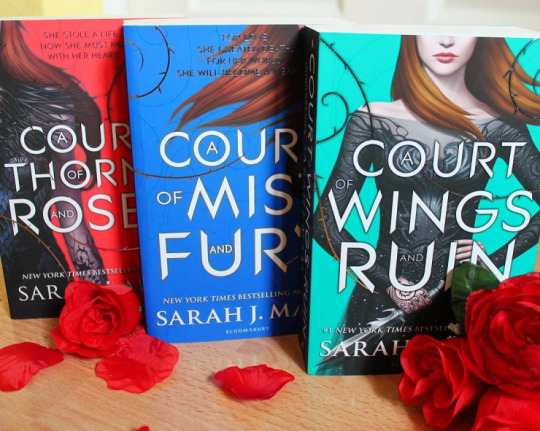
A Court Of Thorns And Roses Trilogy by Sarah J Maas
This (admittedly loose) Beauty And The Beast retelling is one of my favourite books that I have read this year. It is fast paced, action filled and so interesting. I couldn’t put it down. In this story you watch teenager Feyre trade her freedom for the lives of her family. Forced to leave her human life behind her, she is taken to Prythian, the fairy world. While there she discovers the secrets of the world, makes friends and slowly falls in love. This is a brilliant story. It is so gripping; I couldn’t put it down. (and that is just the first book!). If you haven’t read this series yet, you need to.
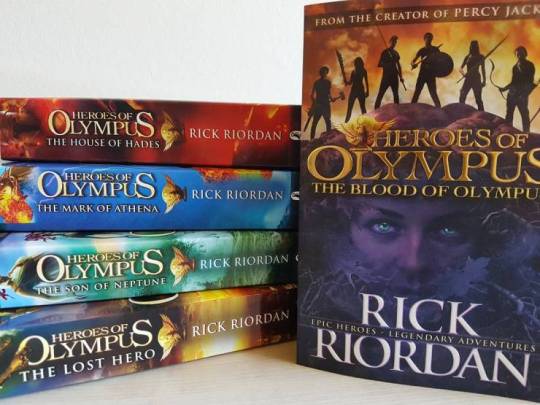
Heroes Of Olympus by Rick Riordan
I know that I have mentioned this series in a previous reads post, but it needs to be in this one as well. This series is amazing. It follows on from the original Percy Jackson books but has a whole host of new characters and a completely new storyline. I would go as far as to say it is better than the original series. It is darker and more complex. The story follows the group as they battle their way across the world trying to unite their friends and prevent the goddess Gia from waking and destroying the world. This series is absolutely incredible; you will want to marathon the books. It is the perfect series to escape into.
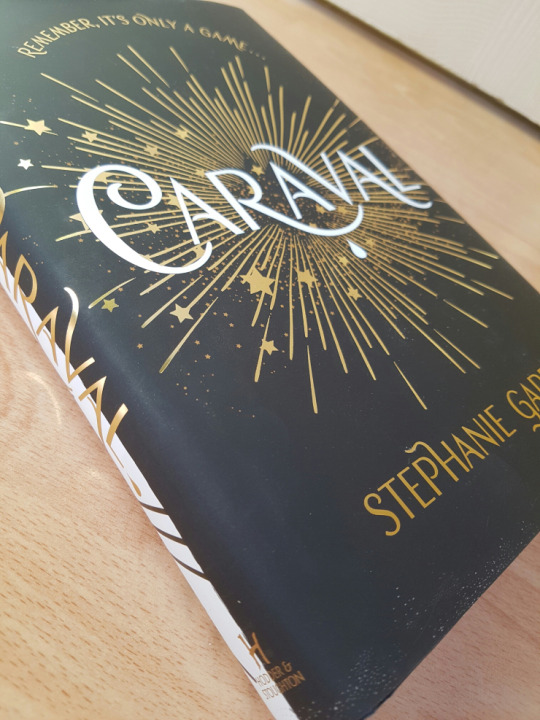
Caraval by Stephanie Garber
This book is essentially the YA equivalent of The Night Circus. It is beautiful, magical, imaginative and quiet dark. The story follows sisters Scarlet and Tella as they venture into the game of Caraval, looking for an escape from their abusive father and dead end lives. They are thrown into a world of deception, mystery, love and joy. This is one of those stories that you will instantly fall in love with. It will keep you on the edge of your seat the whole time, you never know what way that it is going to twist next. You never know what is real, and what isn’t. I truly love this book.
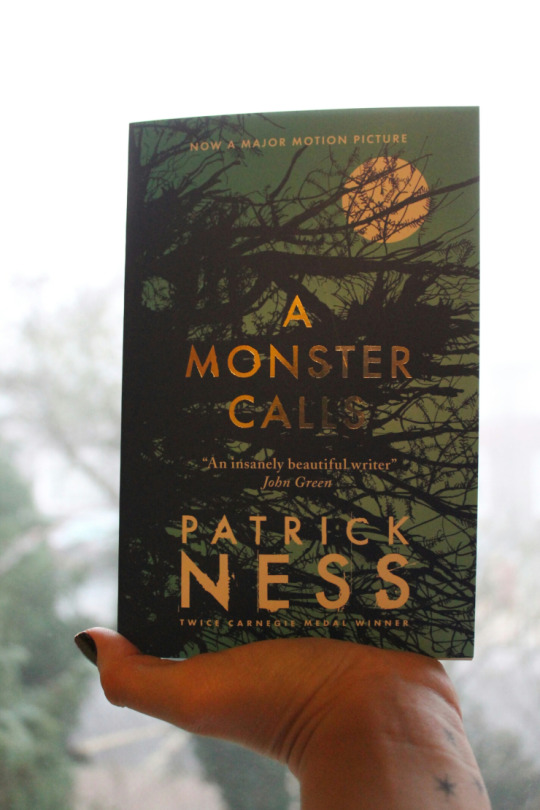
A Monster Calls Patrick Ness
This is a stunningly beautiful book. It is essentially a contemporary story, but with a fantasy, supernatural twist running through it. In this book you follow teenager Conor as he deals with all the emotions and struggles of his mother’s illness. When he is visited by a monster, you learn some very important life lessons with him. This book is absolutely incredible. You will sob uncontrollably but you won’t care. As soon as you start reading it, you won’t want to put it down. It is the perfect book to curl up with on a cold winter day.

The Hate U Give by Angie Thomas
if you are only going to read one book this year, it needs to be this one. This incredible YA contemporary follows 16-year-old Starr as she witnesses her best friend get murdered by a cop, and the aftermath of this event. The whole book is themed around the black lives matter movement and is such an important read. But not only is a topic that we all need to focus on and tackle more, the book itself is incredible. You are instantly so connected to the characters and you want justice for them. Honestly, everybody needs to read this book.
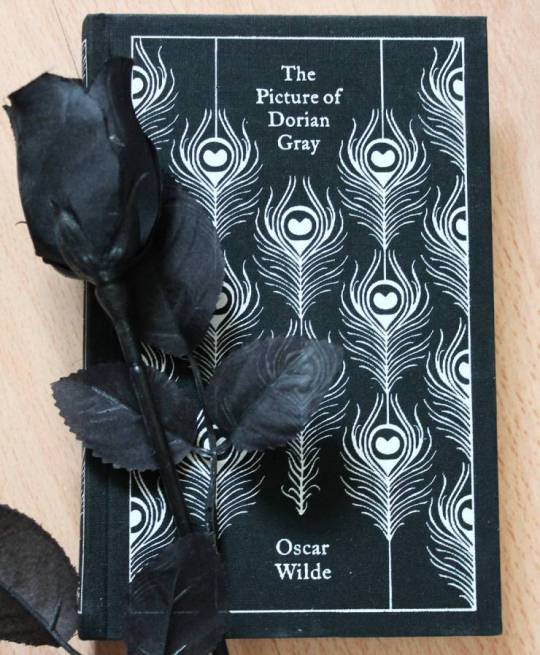
The Picture Of Dorian Gray by Oscar Wilde
I freaking love this book. Generally speaking, I am not a massive fan of classics, but I adored this book. I had been wanting to read it for about five years and finally, after seeing the film, I decided to give it a go and I am so glad that I did. This is the ultimate story of consequences and depravity and it is just amazing. If you haven’t read this, you need to.

Moxie by Jennifer Mathieu
You need to read this book. Follow 16-year-old Vivian through most of the junior year at East Rockport High. At this very corrupted school, the football team are hailed as gods, allowed to do as they please with no repercussions, not even by teachers. Viv has had enough of ‘make me a sandwich’ comments, strictly enforced dress codes that only target girls, being grouped in hallways and all the other stuff that is going on at her school. So, taking inspiration from her ex rebel mother, she starts a zine called Moxie and triggers a revolution. This is a brilliant book. It explores feminism and girl’s rights and the idea that one girl can cause a change. I read this in just one sitting. It is brilliant. Everyone needs to read it.
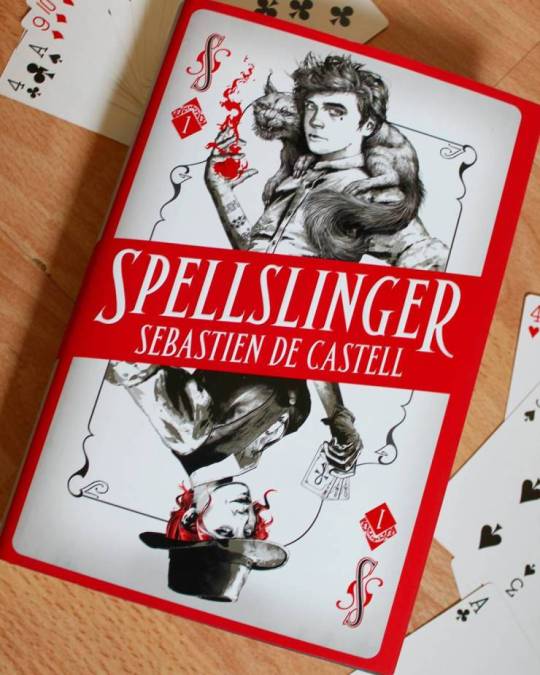
Spellslinger by Sebastien De Castell
welcome to a world of magic and tricks. This is the first book in a new fantasy series and it is incredible. It has instantly become one of my all-time favourite books. In Spellslinger you follow 15-year-old Kellen as he navigates his way through a world where magic is everything. But he has an issue, his is disappearing. You follow him as he tries to uncover the secrets of his magic, untangle a web of lies surrounding him and try to survive long enough to save his sister. This is a fast paced, adrenaline fuelled book that will leave you itching for the next one. A must read for any fantasy lover.
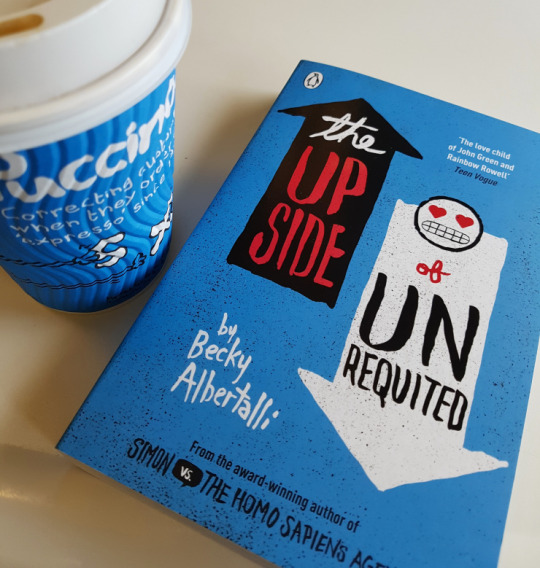
The Upside Of Unrequited by Becky Albertalli
This is hands down the best contemporary that I have read in ages. This story follows 17-year-old Molly over the course of one unforgettable summer. She is the girl who has had 26 crushes, but never done anything about it. this story follows her as she develops crush 27, makes new friends and generally starts to discover who she is. This is a beautiful story full of brilliant characters, and realistic storylines. I have never related to a story as much as I did this one. It is sweet and funny and so good. It is the perfect summer read.

Wilde Like Me by Louise Pentland
When you read this book, you will fall in love with Robin Wilde. This brilliant debut follows 20 something, single mum Robin over a year of her life. You see her deal with everything from mummy issues to dating and the book even touches on elements of mild depression. This book is sweet and funny, daring and brilliant. It has highs and lows and many funny moments. I read this in just two days, it was such a good book and I cannot wait for the next one. It is the perfect summer read.

Maze Runner by James Dashner
This is a truly brilliant trilogy. You follow 16-year-old Thomas as he is thrown into a terrifying world of lies, fear and monsters. With no memories of his old life, you discover and learn about the world alongside him and end up really rooting for him. These are the type of books that you are instantly sucked into and don’t want to put down. There is constantly so much going on. Fighting, adventure, mystery, friendship, drama and so much more. If you want a series that you can really get into, then this is the trilogy for you.

Thirteen Reasons Why by Jay Asher
This is the story of a 17-year-old girl’s suicide. After Hannah takes her own life, tapes suddenly start arriving on her classmate’s doorsteps, on them, Hannah’s reasons for ending her life. Throughout this book you see how people’s actions have consequences, how everything is all linked together and entwined. And how everything can snowball. This is a heart-breaking story and is well worth a read. You will laugh and cry and really connect with the characters. I do suggest listening to this one, is because of the format of the book. The book is told from Clay’s (one of the people who has received the tapes) POV but is primarily Hannah speaking. The audiobook is read by Debra Wiseman and Joel Johnstone who each take a POV. This just makes the story a lot easier to follow and much more enjoyable. There is also something about listening to this that just feels right. Plus, they are both amazing actors who really help to bring the story to life and to connect you to the characters. But however you read it, this is one of those books that you just cannot put down.
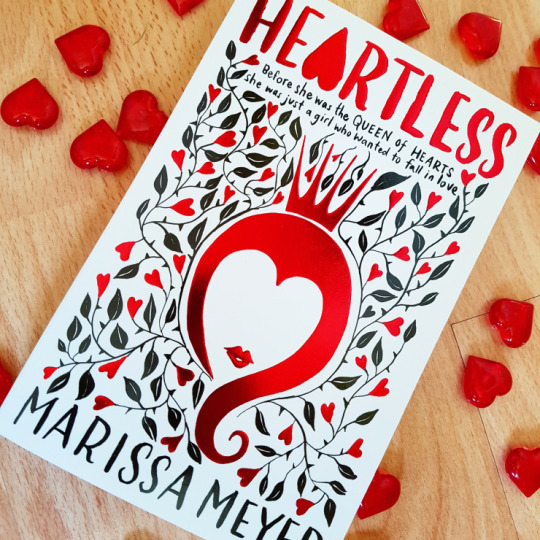
Heartless by Marissa Meyer
I love this book. It is the best Wonderland retelling that I have found so far. In this story you follow Kath, the future Queen of Hearts, as she discovers who she is and who she wants to be. You watch her fall in love with someone she can’t ever have and discover how she became so heartless. This is a really fun, all be it, mildly devastating, story full of love and friendship, cute couples and a lot of whimsy. I would highly recommend the audiobook for this one as it really makes the book.

The Raven Boys by Maggie Stievater
Welcome to the paranormal world. This is the first book in a four-part series that follows a group of friends as they try to find and wake a long dead, and lost, welsh king. The story revolves around ghosts and lay lines, magic and psychics. It is a stunning book and is well worth a read. the writing is almost lyrical, the characters are brilliant and the storylines are so interesting. I cannot wait to continue with the series.
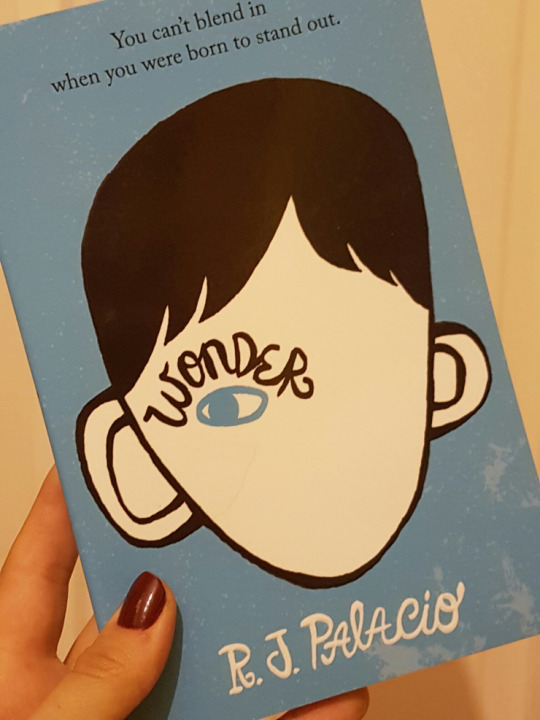
Wonder by R J Palacio
Welcome to the book that will make you think like an 11-year-old again. This book is a contemporary middle grade story about a young boy with serve facial disfigurement. You follow Auggie as he goes to school for the first time. The story is set over the first year of middle school and is told from multiple perspectives. You get chunks of the story from different people. From Auggie himself, to his sister, friends and even his sister’s boyfriend. Each character tells the whole story from their perspective, but also progresses the story. This is a truly stunning book that leaves you with so many feelings. It contains some very important life messages and is a book that everyone needs to read in their lifetime.

Fangirl by Rainbow Rowell
This is one of my favourite contemporaries that I have read this year. It follows 18-year-old Cath, an avid fanfiction writer, as she navigates her way through her first year of college. this book is full of brilliant characters, amazing relationships and complex storylines. You cannot help but fall in love with the characters and the storyline. It is sweet and funny, but also sad and so relatable. This story was so much more complex then I was expecting and I ended up really enjoying it.
Mortal Instruments + Bane Chronicles by Cassandra Clare
this is without a doubt one of the best YA fantasy series, ever. It is full of adventure and drama, mystery and love, creatures and friendship. This is one of those series that that will always have you on the edge f your seat. You will want to read them all back to back. The series follows teenager Clary as she uncovers who she really is and is thrown head-first into the world of Shadowhunter’s and Downworlders. With amazing storylines, interesting characters, endless twists and a sprinkling of humour, this is the perfect series to curl up with and lose yourself in.
Have you ever wondered about Magnus Bane’s life? Then this is the book for you. This is a novella bind up centred around him. every story is from his point of view and it is amazing. You get so many little glimpses into his past, from meeting the formation of the accords to his first date with Alec. this book has it all. This is a must read for any fan of the Shadowhunter world.
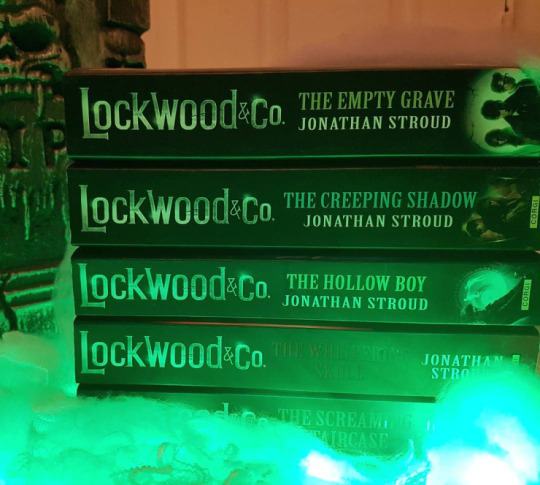
Lockwood And Co by Jonathan Stroud
This is a middle grade series, which I would never give to a middle grader. The Lockwood & Co series focuses around a ghost hunting, private investigator agency. The series is set in a universe where ghost freely wonder the streets at night and it is up to children/teenagers (the only people that can actively see them) to hunt them and take them down. The books follow a specific agency ‘Lockwood & Co’ on their adventures. These books sound light-hearted, but they aren’t. Yes, there are a lot funny moments, but there are also lots of scary and disturbing ones as well. For instance, there is a moment in the first book with a bleeding room and a well were monks were buried alive. Definitely not a book I would give to anyone under 16, but it is a very good read. perfect for Halloween.
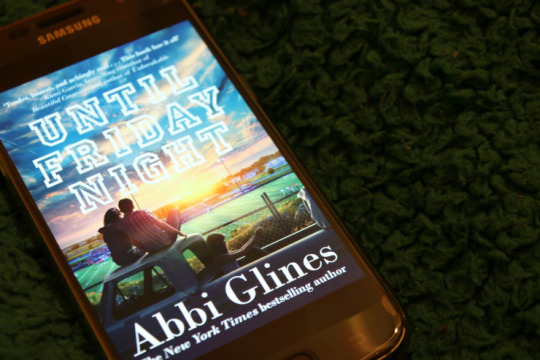
Until Friday Night by Abbi Glines
This is a stunning YA contemporary that follows two teenagers, Maggie and West, as they both struggle to come to terms with losing a parent. The pair connect over their joint experiences and slowly fall for each other. This is a beautiful story about loss and love, friendship and trust, and the idea that no two people experience the same thing, in the same way. It is honestly such a good book. It is beautifully written and you will instantly fall in love with the characters and the story. It is the first in a series of companion novels titled ‘The Field Party’ and they are well worth a read.
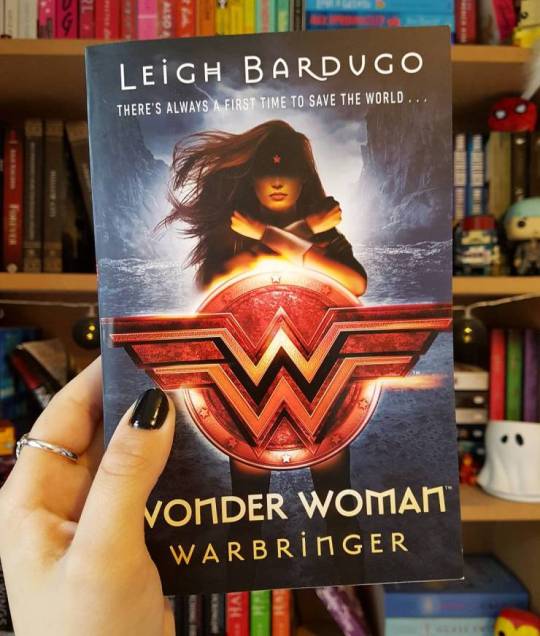
Wonder Woman: Warbringer by Leigh Bardugo
This book is the first in the DC Icons series and features, surprisingly, around Wonder Woman. Well, around Diana, before she was Wonder Woman. You follow her as she helps to save the world for the first time. This book was amazing. It was fast paced and action packed but also really relatable and complex. I loved every second of it. although the actual story is set in the summer time, it is the perfect read for this time of year. I honestly read this in one sitting, I just could not put it down.
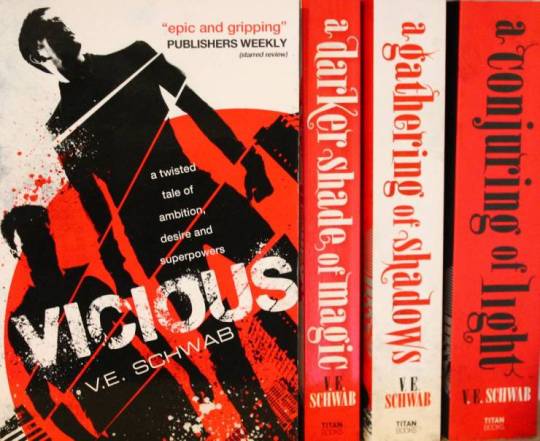
Vicious by V E Schwab
What makes a villain? Read this book and find out. this story follows Victor and Eli, as they try to uncover the secrets of EO’s (extra ordinaries). This is a story about friendship and betrayal, good and evil, heroes and villains. This book has serious X-Men vibes. It boasts complex characters, a storyline that you have to slowly unravel and a completely unique plot. This is the perfect book to sink your teeth into during that autumn time.
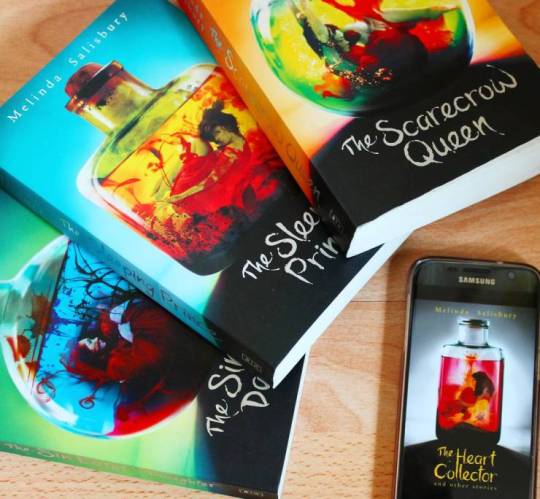
The Scarecrow Queen by Melinda Sailsbury
Welcome to an epic fantasy trilogy. These books follow a pair of teenage of girls, Twylla and Errin, who live in a very different world to ours. This is a world where myths are real and they are coming to get you. You follow the girls as they discover truths and watch their lives intertwine in unexpected ways. These books twist and turn, you never know what is coming next. There is mystery, drama, murder, betrayal and love. Everything that you could possibly want in a story. As soon as you finish one book, you will instantly want to pick up the next. They really are books to sink your teeth into.

Paper Towns by John Green
Paper Towns is the perfect spring contemporary. Set in May, follow Q and his friends as they try to unravel the mystery that is Margo and find out where she has gone. This is a brilliant story about love, isolations, friendship and adventure. You can’t help but fall in love with it. It is sweet and funny but also dark and it tackles some serious topics. It is one of those books that you want to read in one sitting. It is perfect to curl up with during spring and just lose yourself in.

Shadow And Bone by Leigh Bardugo
I got through this book in basically one sitting. This story follows Alina as her world implodes and she is thrown into the world of Grisha’s. as her world is turned upside down she is in a race against time to learn to control her new power and uncover the truth of her new world. This is a brilliant story and I am really looking forward to continuing the series. The world is so interesting. It is truly a book that you can be fully absorbed into.
And those are my favourite reads from 2017! I loved so many books last year, it was a really amazing reading year for me. If you would like to know everything else that I read last year or my bookish goals for 2018, I put a post up last week talking all about it. I will link it below. What did you read last year? what were your favourites? Did any of mine make your list? I hope that you have enjoyed todays post and I will see you all again soon.

My Top 25 Reads Of 2017 Hey Guys! Today I am going to be talking about my favourite reads from last year. I made this post last January about my favourites from 2016 and I love that post.
#2017#a conjuring of light#a court of mist and fury#a court of thorns and roses#a court of wing and ruin#a darker shade of magic#a gathering of shadows#a monster calls#abbi glines#angie thomas#becky albertalli#book#book review#book reviews#books#caraval#cassandra clare#city of ashes#city of bones#city of fallen angels#city of glass#city of heavenly fire#city of lost souls#fangirl#heartless#heroes of olympus#james dashner#jay asher#jennifer mathieu#john green
0 notes